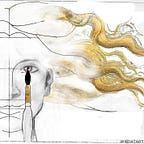The Ultimate Painters Palette Guide
Let’s get it right: the base colours an artist needs.
We delve into the science — a little — and give you the only colours you’ll ever need.
This post originally appeared on my Blog at seanarthurart.com Visit!
We are familiar with the classic colour wheel we learned in grade school, right? From the three primaries — Red Yellow Blue — all other colours can be mixed.
Well, kind of. Mostly, but not really. The reality for artists is more complicated. Here we’ll make it clear, and you will have the only palette you’ll ever need.
First, briefly, let’s understand how colour works. (You can get your PHD in colour science if you want. We’ll wait…)
There are two ways colour is created, with different primary colours in their respective colour wheels. These are the additive system and the subtractive system.
The Primary colours in the additive system are Red Green and Blue. You see these in the old Philips video cables and plugs, the RGB connectors in old game consoles and screens.
This additive system works with light. The surface starts black and colored light is added. The black serves to create all the darks, shadows, greys. As illustrated, when the RGB lights are mixed, you get white. Cyan, Magenta, and Yellow are the secondaries.
YES! When red and green light mix you get yellow. Don’t dispute me.
But we can’t paint with light. TVs and cameras and computer screens use light. We use paint, because we’re painters.
The primary colours in the subtractive system are Cyan, Magenta, and Yellow. Plus black — K. (The K comes from the printing industry.) So CMYK. Red, Blue and Green are the secondaries. This is the Creative’s true colour wheel.
YES, AGAIN! Cyan and Magenta make blue. This is because Cyan is NOT a blue, it is its own colour category — a primary. Just as Magenta is not a red. But Yellow is yellow.
The subtractive system works with paint. The surface begins white and coloured paints are added. The white of the support or ground creates the light for all the brights. (When the paint is not transparent or the ground is covered we use white paint.) Thus our paper and canvases begin white.
As illustrated, when CMY paints are mixed, you get black. However, these paints cannot produce true black, so a black paint is added.
The system is called subtractive because each colour subtracts (absorbs) all the light except the colour that is reflecting back.
Our reality is that no paint maker can make perfectly pure Cyan, Magenta or Yellow. Thus as a Creative, a painter, what paints do you use, out of the hundreds of tubes available, to get full control over your colours?
Luckily the work has already been done for us by artist Jack White, and his wife, artist Mikki Senkarik.
Jack did extensive research and testing and created what he called a ‘double palette’, in reality a ‘warm’ set and a ‘cool’ set of the old primaries, plus Magenta and Cobalt blue, plus colours the old Red, Blue, Yellow primaries cannot mix.
Two of the ‘unmixable’ colours are high transparency CMYK secondary colours (P. Rose, V. Green). Similarly D. Purple is both exceptionally intense and transparent and impossible to mix to get both qualities.
Cobalt Blue is a unique colour because it is a true neutral blue, neither warm nor cool. It is close but not quite Cyan blue, so I add a transparent Cyan blue or its kissing cousin Cerulean Blue.
Here is the Jack White palette:
Ultramarine Blue or French Ultramarine Blue (Warm) — has red
Cadmium Red Light (Warm Red)
Cadmium Yellow Medium (Warm Yellow)
Pthalo Blue (Cool) — has yellow
Alizarin Crimson (Cool Red)
Hansa Lemon Yellow (Cool Yellow) — the Yellow in CMYK
Magenta
Cobalt Blue — (in place of Cyan)
Permanent Rose — replaces Rose Madder, supposedly
Dioxazine Purple
Viridian Green
I must add Schmenke’s transparent Cyan or any good quality Cerulean blue.
And Mikki adds Cadmium Orange [ bec. its a real b**ch to mix.]
White. I’d use Flake (in oils) and Titanium.
Black. Add a blue based black, like Bone Black, to increase shadow complexity. For a long time I’d mix Van Dyke Brown with Dioxazine Purple and then just a touch of black to make amazingly complex shadows. Anyway…
As you try to put together this palette, you’ll discover that it is difficult to find what you want because colour naming is not very uniform. At all. To help, here a a few more notes, this from artist Scott Naismith:
Tube Colours that behave like / are actually magenta:
Permanent Magenta,
quinacridone red,
rose lake
permanent rose
alizarine crimson (but only true, top quality)
Note: No cadmium reds for Scott. As well, nothing with filler. No “Hues”.
Tube Colours like Cyan:
Schmenke transparent Cyan
Cerellian blue
Manganese blue
ME:
Any pure bright transparent yellow will work as a CMYK primary: Lemon Yellow, M. Graham Bismuth Yellow, bright yellow. But not medium or cadmium yellows.
And thats it. All you need. Go get ’em slugger!
This might seem like too much. But you don’t put the whole lot out all at the same time in identically huge piles, if you don’t need to.
Plan your work and decide if you need cooler colours or warmer colours. Are you mixing a lot of variations of green, or almost none? And so on.
Once you have your palette set, of course you can add to it, but this comes as you interact with your subject and the work you’re creating. Watercolors are different from acrylics, and oils are different again.
The beauty of working with a ‘limited palette’ is that it creates harmonies. Shadows seem right, local colours fit, highlights are the correct brightness. Your colours don’t muddy up as easily.
Don’t take my work for it! Put together this set of colours and see for yourself.
Happy Arting,
Sean, October 2020
